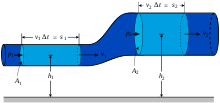- Solid mechanics
-
Continuum mechanics  LawsSolid mechanicsScientists
LawsSolid mechanicsScientistsSolid mechanics is the branch of mechanics, physics, and mathematics that concerns the behavior of solid matter under external actions (e.g., external forces, temperature changes, applied displacements, etc.). It is part of a broader study known as continuum mechanics. One of the most common practical applications of solid mechanics is the Euler-Bernoulli beam equation. Solid mechanics extensively uses tensors to describe stresses, strains, and the relationship between them.
Contents
Relationship to continuum mechanics
As shown in the following table, solid mechanics inhabits a central place within continuum mechanics. The field of rheology presents an overlap between solid and fluid mechanics.
Continuum mechanics
The study of the physics of continuous materialsSolid mechanics
The study of the physics of continuous materials with a defined rest shape.Elasticity
Describes materials that return to their rest shape after an applied stress.Plasticity
Describes materials that permanently deform after a sufficient applied stress.Rheology
The study of materials with both solid and fluid characteristics.Fluid mechanics
The study of the physics of continuous materials which take the shape of their container.Non-Newtonian fluids Newtonian fluids Response models
A material has a rest shape and its shape departs away from the rest shape due to stress. The amount of departure from rest shape is called deformation, the proportion of deformation to original size is called strain. If the applied stress is sufficiently low (or the imposed strain is small enough), almost all solid materials behave in such a way that the strain is directly proportional to the stress; the coefficient of the proportion is called the modulus of elasticity or Young's modulus. This region of deformation is known as the linearly elastic region.
It is most common for analysts in solid mechanics to use linear material models, due to ease of computation. However, real materials often exhibit non-linear behavior. As new materials are used and old ones are pushed to their limits, non-linear material models are becoming more common.
There are three models that describe how a solid responds to an applied stress:
- Elastically – When an applied stress is removed, the material returns to its undeformed state. Linearly elastic materials, those that deform proportionally to the applied load, can be described by the linear elasticity equations such as Hooke's law.
- Viscoelastically – These are materials that behave elastically, but also have damping: when the stress is applied and removed, work has to be done against the damping effects and is converted in heat within the material resulting in a hysteresis loop in the stress–strain curve. This implies that the material response has time-dependence.
- Plastically – Materials that behave elastically generally do so when the applied stress is less than a yield value. When the stress is greater than the yield stress, the material behaves plastically and does not return to its previous state. That is, deformation that occurs after yield is permanent.
See also
- Strength of materials - Specific definitions and the relationships between stress and strain.
- Applied mechanics
- Viscosity
- Thermoplasticity
- Materials science
- Chord modulus
- Continuum mechanics
- Movable cellular automaton
- Fracture mechanics
References
- L.D. Landau, E.M. Lifshitz, Course of Theoretical Physics: Theory of Elasticity Butterworth-Heinemann, ISBN 0-7506-2633-X
- J.E. Marsden, T.J. Hughes, Mathematical Foundations of Elasticity, Dover, ISBN 0-486-67865-2
- P.C. Chou, N. J. Pagano, Elasticity: Tensor, Dyadic, and Engineering Approaches, Dover, ISBN 0-486-66958-0
- R.W. Ogden, Non-linear Elastic Deformation, Dover, ISBN 0-486-69648-0
- S. Timoshenko and J.N. Goodier," Theory of elasticity", 3d ed., New York, McGraw-Hill, 1970.
- A.I. Lurie, "Theory of Elasticity", Springer, 1999.
- L.B. Freund, "Dynamic Fracture Mechanics", Cambridge University Press, 1990.
- R. Hill, "The Mathematical Theory of Plasticity", Oxford University, 1950.
- J. Lubliner, "Plasticity Theory", Macmillan Publishing Company, 1990.
Categories:
Wikimedia Foundation. 2010.
